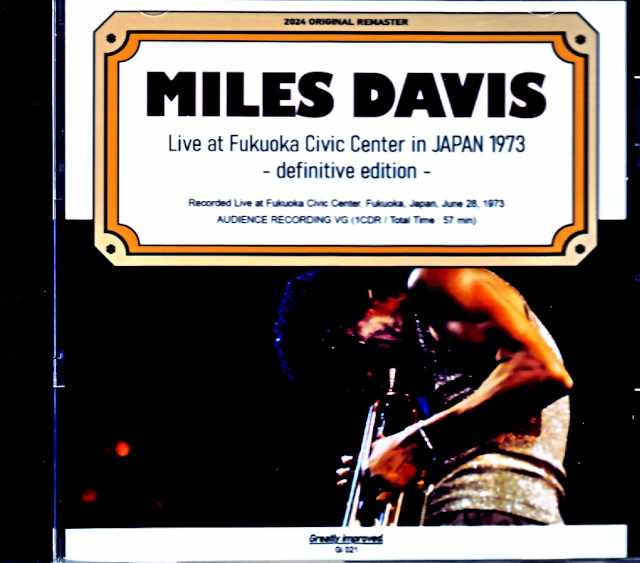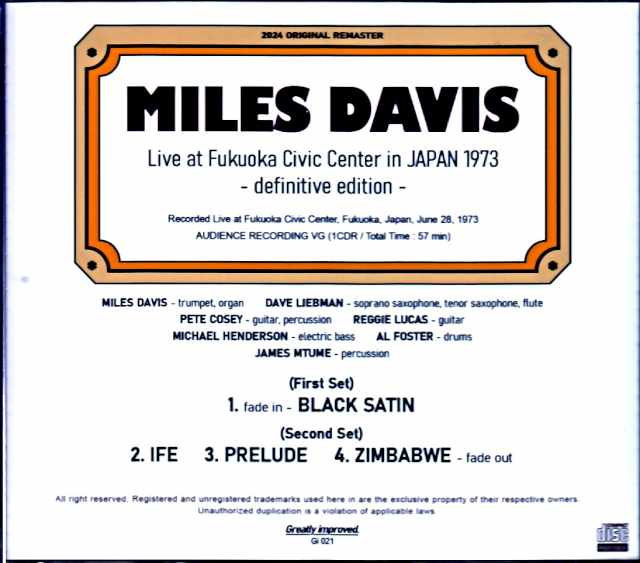Miles Davis Dave Liebman,Michael Henderson/Fukuoka,Japan 1973 Upgrade
Miles Davis Dave Liebman,Michael Henderson/Fukuoka,Japan 1973 Upgrade
 $50 off your first order over $150 - Code"2SJKFRTS73YV"
$50 off your first order over $150 - Code"2SJKFRTS73YV"
 10% off orders over $100 = Duty-Free Shopping! - Code"1ZYT23AJQRTD"
10% off orders over $100 = Duty-Free Shopping! - Code"1ZYT23AJQRTD"
 Free Shipping on Every Order!
Free Shipping on Every Order!
Handling time
Generally 7 days. Will not ship on Thursday, Saturday, and Sunday
It is the buyer responsibility to pay for the custom fees and taxes.
Couldn't load pickup availability
Share


The legendary 1973 Japan tour of the most popular Miles band of the 70s, which was a tight lineup from the raging 10-person band, has been released with the definitive version of the phantom Fukuoka performance, where the classic song "Black Satin" that everyone wants to hear was the only one set! ! Miles put an extraordinary effort into the 1973 Japan tour, such as doing a reversal for four hours straight at the NHK studio the day before the tour. Here we will organize the dates and locations of the 1973 (Showa 48) Japan tour. 6/16 Hokkaido Welfare Pension Hall 6/19 Tokyo Shinjuku Welfare Pension Hall (1st & 2nd) 6/20 Tokyo Shinjuku Welfare Pension Association (1st & 2nd) 6/22 Tokyo Shinjuku Welfare Pension Hall 6/23 Nagoya Civic Hall 6/25 Kyoto Hall 6/28 Fukuoka Civic Hall 6/29 Hiroshima Postal Savings Hall 6/30 Osaka Festival Hall (1st & 2nd) 7/1 Kanazawa Tourist Hall 7/3 Niigata Prefectural Civic Hall Incidentally, tickets for S seats were 4,800 yen, more expensive than Stan Getz (3,000 yen) and Cecil Taylor (2,500 yen), who came to Japan at the same time, but they sold out in an instant. It is. There are still very few recordings available compared to the 1975 Japan tour, but this is probably due to the difference in the prevalence of recording equipment such as cassette decks. So far, apart from the June 19th and 20th broadcasts at Tokyo Shinjuku Koseinenkin Hall on radio and television, the only live performance that has been released is the one at Fukuoka Civic Hall on June 28th. Even just listening to this Fukuoka performance is a bonus. The PA system and sound equipment at the venue at that time were completely different from today, and anyone who has experienced an electric rock concert of that era will understand that the bass was loud and had a hazy, foggy sound image. Unfortunately, the Fukuoka performance was exactly that. However, just as the acoustic environment has evolved, with the evolution of various technologies, such sound sources have been improved in sound quality, balance, and everything else to the point that they can be heard at a glance (of course, this is only possible for professional-level artists), and this June 28, 1973 Fukuoka Civic Hall performance has finally been scalpeled, and is this really that Fukuoka? It's a real eye-opener! Come on, listen to it! ! The album contains four songs, and the first set starts with "Black Satin". As mentioned above, only three performances of the 1973 Japan tour saw the light of day, so it is difficult to say for sure, but this "Black Satin" was recorded in 1972 and was an arrangement song featuring Lonnie Liston Smith's keyboard, so it was rare for it to be performed by the 7-person Miles band in 1973, and it is said that it was only set in Fukuoka at the Japan tour. Come to think of it, Ronnie was also announced as one of the members to come to Japan at the time. The Japan tour pamphlet was the same. That means Ronnie may have been a member until just before coming to Japan and left just before. In the previously released version, only the strange atmosphere unique to this song was clear, but this update clearly shows the wild excitement. Unfortunately, only the second half is recorded, but the performance of "Black Satin" with this lineup, especially in Japan, is exciting whether you like it or not! The other three songs are from the second set, and "Ife" is particularly great, as it is played for a long time. Miles plays such a long solo that you wonder how long it will last. You can almost picture him playing the wah-wah echoing trumpet with his foot pedal, pointing it downwards. Listening to "Prelude" and "Zimbabwe" that follow, you can see that Miles' music reached a peak in Japan in 1973. His music has progressed significantly since "In Concert" nine months earlier, and even with fewer members, he is able to express more diversely. The rhythm created by the seven members, led by Miles, contains various elements such as rock, blues, funk, and Afro, and creates an ideal polyrhythm. Miles later reminisced, "In live performances, this group was the best. I had changed many players and instruments up until that point, but this band was the closest to the sound I wanted as a working band." Compared to the 1975 Japan performance, there are still few recordings of the 1973 Japan visit, but the only local performance that can be heard at present has arrived in a happy updated definitive version!



